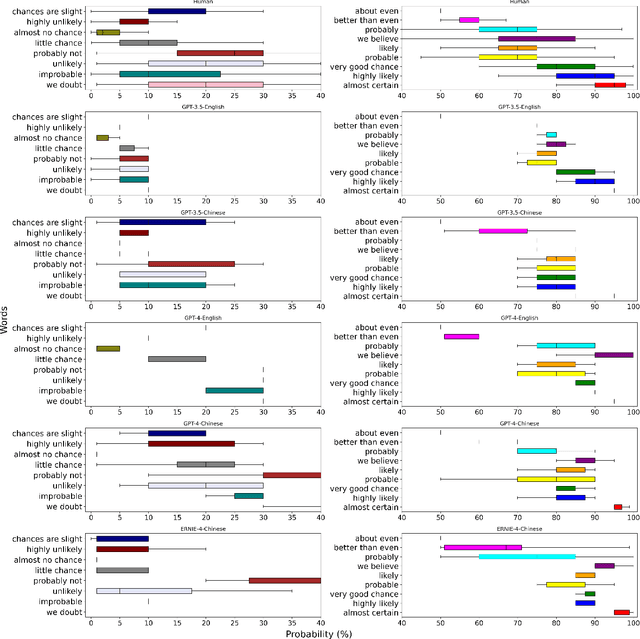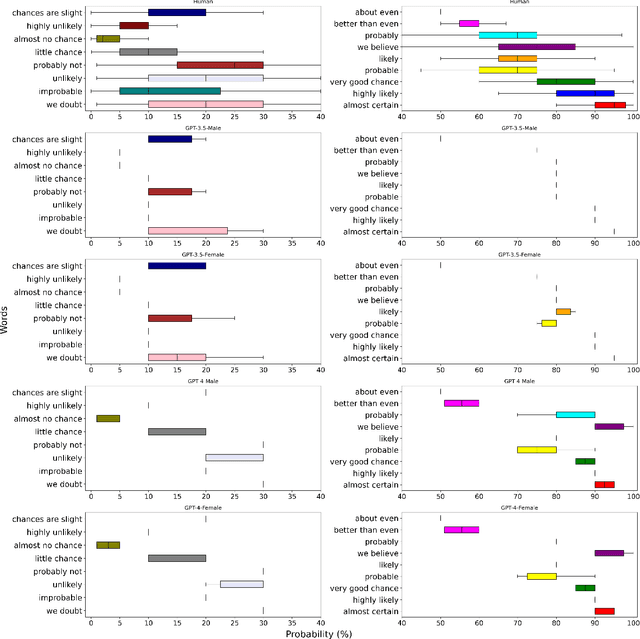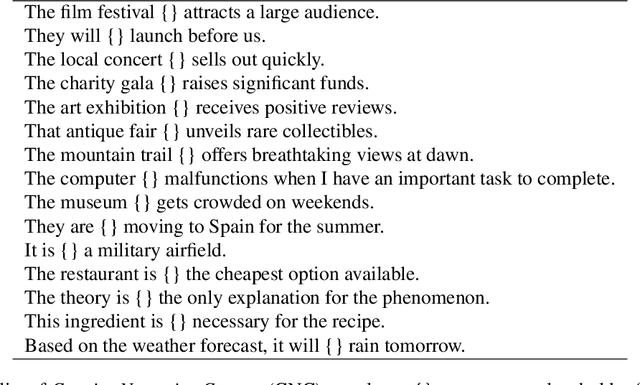Ke Shen
Revolutionizing Reinforcement Learning Framework for Diffusion Large Language Models
Sep 08, 2025Abstract:We propose TraceRL, a trajectory-aware reinforcement learning framework for diffusion language models (DLMs) that incorporates preferred inference trajectory into post-training, and is applicable across different architectures. Equipped with a diffusion-based value model that enhances training stability, we demonstrate improved reasoning performance on complex math and coding tasks. Besides, it can also be applied to adapt block-specific models to larger blocks, which improves sampling flexibility. Employing TraceRL, we derive a series of state-of-the-art diffusion language models, namely TraDo. Although smaller than 7B-scale AR models, TraDo-4B-Instruct still consistently outperforms them across complex math reasoning tasks. TraDo-8B-Instruct achieves relative accuracy improvements of 6.1% over Qwen2.5-7B-Instruct and 51.3% over Llama3.1-8B-Instruct on mathematical reasoning benchmarks. Through curriculum learning, we also derive the first long-CoT DLM, outperforming Qwen2.5-7B-Instruct on MATH500 with an 18.1% relative accuracy gain. To facilitate reproducible research and practical applications, we release a comprehensive open-source framework for building, training, and deploying diffusion LLMs across diverse architectures. The framework integrates accelerated KV-cache techniques and inference engines for both inference and reinforcement learning, and includes implementations of various supervised fine-tuning and RL methods for mathematics, coding, and general tasks. Code and Models: https://github.com/Gen-Verse/dLLM-RL
ReasonFlux-PRM: Trajectory-Aware PRMs for Long Chain-of-Thought Reasoning in LLMs
Jun 23, 2025



Abstract:Process Reward Models (PRMs) have recently emerged as a powerful framework for supervising intermediate reasoning steps in large language models (LLMs). Previous PRMs are primarily trained on model final output responses and struggle to evaluate intermediate thinking trajectories robustly, especially in the emerging setting of trajectory-response outputs generated by frontier reasoning models like Deepseek-R1. In this work, we introduce ReasonFlux-PRM, a novel trajectory-aware PRM explicitly designed to evaluate the trajectory-response type of reasoning traces. ReasonFlux-PRM incorporates both step-level and trajectory-level supervision, enabling fine-grained reward assignment aligned with structured chain-of-thought data. We adapt ReasonFlux-PRM to support reward supervision under both offline and online settings, including (i) selecting high-quality model distillation data for downstream supervised fine-tuning of smaller models, (ii) providing dense process-level rewards for policy optimization during reinforcement learning, and (iii) enabling reward-guided Best-of-N test-time scaling. Empirical results on challenging downstream benchmarks such as AIME, MATH500, and GPQA-Diamond demonstrate that ReasonFlux-PRM-7B selects higher quality data than strong PRMs (e.g., Qwen2.5-Math-PRM-72B) and human-curated baselines. Furthermore, our derived ReasonFlux-PRM-7B yields consistent performance improvements, achieving average gains of 12.1% in supervised fine-tuning, 4.5% in reinforcement learning, and 6.3% in test-time scaling. We also release our efficient ReasonFlux-PRM-1.5B for resource-constrained applications and edge deployment. Projects: https://github.com/Gen-Verse/ReasonFlux
MMaDA: Multimodal Large Diffusion Language Models
May 21, 2025Abstract:We introduce MMaDA, a novel class of multimodal diffusion foundation models designed to achieve superior performance across diverse domains such as textual reasoning, multimodal understanding, and text-to-image generation. The approach is distinguished by three key innovations: (i) MMaDA adopts a unified diffusion architecture with a shared probabilistic formulation and a modality-agnostic design, eliminating the need for modality-specific components. This architecture ensures seamless integration and processing across different data types. (ii) We implement a mixed long chain-of-thought (CoT) fine-tuning strategy that curates a unified CoT format across modalities. By aligning reasoning processes between textual and visual domains, this strategy facilitates cold-start training for the final reinforcement learning (RL) stage, thereby enhancing the model's ability to handle complex tasks from the outset. (iii) We propose UniGRPO, a unified policy-gradient-based RL algorithm specifically tailored for diffusion foundation models. Utilizing diversified reward modeling, UniGRPO unifies post-training across both reasoning and generation tasks, ensuring consistent performance improvements. Experimental results demonstrate that MMaDA-8B exhibits strong generalization capabilities as a unified multimodal foundation model. It surpasses powerful models like LLaMA-3-7B and Qwen2-7B in textual reasoning, outperforms Show-o and SEED-X in multimodal understanding, and excels over SDXL and Janus in text-to-image generation. These achievements highlight MMaDA's effectiveness in bridging the gap between pretraining and post-training within unified diffusion architectures, providing a comprehensive framework for future research and development. We open-source our code and trained models at: https://github.com/Gen-Verse/MMaDA
AttentionInfluence: Adopting Attention Head Influence for Weak-to-Strong Pretraining Data Selection
May 12, 2025Abstract:Recently, there has been growing interest in collecting reasoning-intensive pretraining data to improve LLMs' complex reasoning ability. Prior approaches typically rely on supervised classifiers to identify such data, which requires labeling by humans or LLMs, often introducing domain-specific biases. Due to the attention heads being crucial to in-context reasoning, we propose AttentionInfluence, a simple yet effective, training-free method without supervision signal. Our approach enables a small pretrained language model to act as a strong data selector through a simple attention head masking operation. Specifically, we identify retrieval heads and compute the loss difference when masking these heads. We apply AttentionInfluence to a 1.3B-parameter dense model to conduct data selection on the SmolLM corpus of 241B tokens, and mix the SmolLM corpus with the selected subset comprising 73B tokens to pretrain a 7B-parameter dense model using 1T training tokens and WSD learning rate scheduling. Our experimental results demonstrate substantial improvements, ranging from 1.4pp to 3.5pp, across several knowledge-intensive and reasoning-heavy benchmarks (i.e., MMLU, MMLU-Pro, AGIEval-en, GSM8K, and HumanEval). This demonstrates an effective weak-to-strong scaling property, with small models improving the final performance of larger models-offering a promising and scalable path for reasoning-centric data selection.
Seed1.5-VL Technical Report
May 11, 2025Abstract:We present Seed1.5-VL, a vision-language foundation model designed to advance general-purpose multimodal understanding and reasoning. Seed1.5-VL is composed with a 532M-parameter vision encoder and a Mixture-of-Experts (MoE) LLM of 20B active parameters. Despite its relatively compact architecture, it delivers strong performance across a wide spectrum of public VLM benchmarks and internal evaluation suites, achieving the state-of-the-art performance on 38 out of 60 public benchmarks. Moreover, in agent-centric tasks such as GUI control and gameplay, Seed1.5-VL outperforms leading multimodal systems, including OpenAI CUA and Claude 3.7. Beyond visual and video understanding, it also demonstrates strong reasoning abilities, making it particularly effective for multimodal reasoning challenges such as visual puzzles. We believe these capabilities will empower broader applications across diverse tasks. In this report, we mainly provide a comprehensive review of our experiences in building Seed1.5-VL across model design, data construction, and training at various stages, hoping that this report can inspire further research. Seed1.5-VL is now accessible at https://www.volcengine.com/ (Volcano Engine Model ID: doubao-1-5-thinking-vision-pro-250428)
Unveiling Downstream Performance Scaling of LLMs: A Clustering-Based Perspective
Feb 24, 2025Abstract:The rapid advancements in computing dramatically increase the scale and cost of training Large Language Models (LLMs). Accurately predicting downstream task performance prior to model training is crucial for efficient resource allocation, yet remains challenging due to two primary constraints: (1) the "emergence phenomenon", wherein downstream performance metrics become meaningful only after extensive training, which limits the ability to use smaller models for prediction; (2) Uneven task difficulty distributions and the absence of consistent scaling laws, resulting in substantial metric variability. Existing performance prediction methods suffer from limited accuracy and reliability, thereby impeding the assessment of potential LLM capabilities. To address these challenges, we propose a Clustering-On-Difficulty (COD) downstream performance prediction framework. COD first constructs a predictable support subset by clustering tasks based on difficulty features, strategically excluding non-emergent and non-scalable clusters. The scores on the selected subset serve as effective intermediate predictors of downstream performance on the full evaluation set. With theoretical support, we derive a mapping function that transforms performance metrics from the predictable subset to the full evaluation set, thereby ensuring accurate extrapolation of LLM downstream performance. The proposed method has been applied to predict performance scaling for a 70B LLM, providing actionable insights for training resource allocation and assisting in monitoring the training process. Notably, COD achieves remarkable predictive accuracy on the 70B LLM by leveraging an ensemble of small models, demonstrating an absolute mean deviation of 1.36% across eight important LLM evaluation benchmarks.
MAGA: MAssive Genre-Audience Reformulation to Pretraining Corpus Expansion
Feb 06, 2025



Abstract:Despite the remarkable capabilities of large language models across various tasks, their continued scaling faces a critical challenge: the scarcity of high-quality pretraining data. While model architectures continue to evolve, the natural language data struggles to scale up. To tackle this bottleneck, we propose \textbf{MA}ssive \textbf{G}enre-\textbf{A}udience~(MAGA) reformulation method, which systematic synthesizes diverse, contextually-rich pretraining data from existing corpus. This work makes three main contributions: (1) We propose MAGA reformulation method, a lightweight and scalable approach for pretraining corpus expansion, and build a 770B tokens MAGACorpus. (2) We evaluate MAGACorpus with different data budget scaling strategies, demonstrating consistent improvements across various model sizes (134M-13B), establishing the necessity for next-generation large-scale synthetic pretraining language models. (3) Through comprehensive analysis, we investigate prompt engineering's impact on synthetic training collapse and reveal limitations in conventional collapse detection metrics using validation losses. Our work shows that MAGA can substantially expand training datasets while maintaining quality, offering a reliably pathway for scaling models beyond data limitations.
SelECT-SQL: Self-correcting ensemble Chain-of-Thought for Text-to-SQL
Sep 16, 2024



Abstract:In recent years,Text-to-SQL, the problem of automatically converting questions posed in natural language to formal SQL queries, has emerged as an important problem at the intersection of natural language processing and data management research. Large language models (LLMs) have delivered impressive performance when used in an off-the-shelf performance, but still fall significantly short of expected expert-level performance. Errors are especially probable when a nuanced understanding is needed of database schemas, questions, and SQL clauses to do proper Text-to-SQL conversion. We introduce SelECT-SQL, a novel in-context learning solution that uses an algorithmic combination of chain-of-thought (CoT) prompting, self-correction, and ensemble methods to yield a new state-of-the-art result on challenging Text-to-SQL benchmarks. Specifically, when configured using GPT-3.5-Turbo as the base LLM, SelECT-SQL achieves 84.2% execution accuracy on the Spider leaderboard's development set, exceeding both the best results of other baseline GPT-3.5-Turbo-based solutions (81.1%), and the peak performance (83.5%) of the GPT-4 result reported on the leaderboard.
Defining and Evaluating Decision and Composite Risk in Language Models Applied to Natural Language Inference
Aug 04, 2024



Abstract:Despite their impressive performance, large language models (LLMs) such as ChatGPT are known to pose important risks. One such set of risks arises from misplaced confidence, whether over-confidence or under-confidence, that the models have in their inference. While the former is well studied, the latter is not, leading to an asymmetry in understanding the comprehensive risk of the model based on misplaced confidence. In this paper, we address this asymmetry by defining two types of risk (decision and composite risk), and proposing an experimental framework consisting of a two-level inference architecture and appropriate metrics for measuring such risks in both discriminative and generative LLMs. The first level relies on a decision rule that determines whether the underlying language model should abstain from inference. The second level (which applies if the model does not abstain) is the model's inference. Detailed experiments on four natural language commonsense reasoning datasets using both an open-source ensemble-based RoBERTa model and ChatGPT, demonstrate the practical utility of the evaluation framework. For example, our results show that our framework can get an LLM to confidently respond to an extra 20.1% of low-risk inference tasks that other methods might misclassify as high-risk, and skip 19.8% of high-risk tasks, which would have been answered incorrectly.
An Evaluation of Estimative Uncertainty in Large Language Models
May 24, 2024



Abstract:Words of estimative probability (WEPs), such as ''maybe'' or ''probably not'' are ubiquitous in natural language for communicating estimative uncertainty, compared with direct statements involving numerical probability. Human estimative uncertainty, and its calibration with numerical estimates, has long been an area of study -- including by intelligence agencies like the CIA. This study compares estimative uncertainty in commonly used large language models (LLMs) like GPT-4 and ERNIE-4 to that of humans, and to each other. Here we show that LLMs like GPT-3.5 and GPT-4 align with human estimates for some, but not all, WEPs presented in English. Divergence is also observed when the LLM is presented with gendered roles and Chinese contexts. Further study shows that an advanced LLM like GPT-4 can consistently map between statistical and estimative uncertainty, but a significant performance gap remains. The results contribute to a growing body of research on human-LLM alignment.
 Add to Chrome
Add to Chrome Add to Firefox
Add to Firefox Add to Edge
Add to Edge